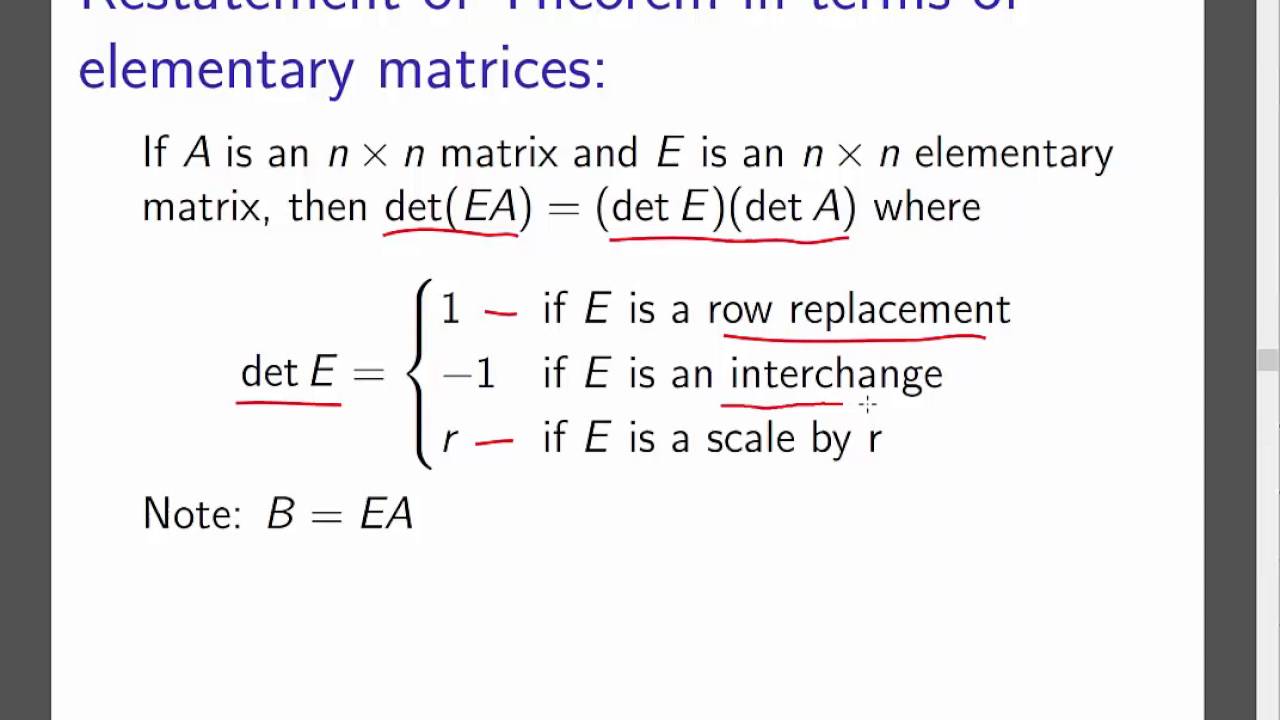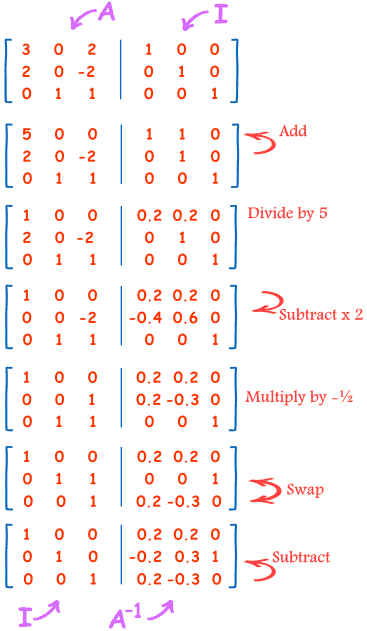
MATH 304 Linear Algebra Rank, Row-Reduced Form, and Solutions to Example 1. Consider the matrix A given by. Using the three elementary row operations we may rewrite A in an echelon form as or, continuing with additional row operations, in the reduced row-echelon form. From the above, the homogeneous system has a solution that can be read as or in vector form as.
Elementary row operations and some applications
Elementary Row Operations MathOnWeb. ES.1803 Topic 14 Notes Jeremy Orlo 14 Row reduction and subspaces 14.1 Goals 1.Be able to put a matrix into row reduced echelon form (RREF) using elementary row operations. 2.Know the de nitions of null and column space of a matrix. 3.Be able to use RREF to nd bases and describe the null and column spaces of a matrix., Elementary matrix row operations. Matrix row operations. Practice: Matrix row operations. This is the currently selected item. Next lesson. Row-echelon form and Gaussian elimination. Matrix row operations. Determine the matrix that is the result of performing a specific row operation on a given matrix. If you're seeing this message, it means we're having trouble loading external resources on.
Gaussian elimination, also known as row reduction, is an algorithm in linear algebra for solving a system of linear equations. It is usually understood as a sequence of operations performed on the corresponding matrix of coefficients. Elementary matrix operations play an important role in many matrix algebra applications, such as finding the inverse of a matrix and solving simultaneous linear equations. There are three kinds of elementary matrix operations. Interchange two rows (or columns). Multiply each element in a row (or
The Center for Academic Support (CAS) provides one-on-one and small group tutoring for most courses on campus. Located on the northeast corner of the library building, the Center consists of group study spaces and a large open area for students to receive tutoring or work independently. abelian group augmented matrix basis basis for a vector space characteristic polynomial commutative ring determinant determinant of a matrix diagonalization diagonal matrix eigenvalue eigenvector elementary row operations exam field theory finite group group group homomorphism group theory homomorphism ideal inverse matrix invertible matrix kernel linear algebra linear combination linearly
Elementary row operations. by Marco Taboga, PhD. Elementary row operations are simple operations that allow to transform a system of linear equations into an equivalent system, that is, into a new system of equations having the same solutions as the original system. elementary row transformations. If we want to perform an elementary row transformation on a matrix A, it is enough to pre-multiply A by the elemen-tary matrix obtained from the identity by the same transformation. This is illustrated below for each of the three elementary row transformations. 1.5.2 Elementary Matrices and Elementary Row Opera-tions
abelian group augmented matrix basis basis for a vector space characteristic polynomial commutative ring determinant determinant of a matrix diagonalization diagonal matrix eigenvalue eigenvector elementary row operations exam field theory finite group group group homomorphism group theory homomorphism ideal inverse matrix invertible matrix kernel linear algebra linear combination linearly Write down the corresponding augmented matrix, use elementary row operations to put this matrix in reduced row echelon form. Hence nd all solutions of this system and give a geometric interpration of your answer. 3. See Page 5 for worked solutions. Suppose an augmented matrix associated with a system of linear equations has the
It can be proven that any m n matrix can be put in row-reduced echelon form by elementary row operations, and the reduced row-reduced echelon matrix is unique. It is easy to see how to carry out the procedure. One starts by putting a one as the rst nonzero entry in the rst row of the rst nonzero column. 21.12.2015 · The elementary column operations are exactly the same operations done on the columns. Elementary Column Operation: Those three operations for rows, if applied to columns in the same way, we get elementary column operation. As we have already discussed row transformation in detail, we will briefly discuss column transformation. The rules for
2.4 Elementary Row Operations and Row-Echelon Matrices 143 Example 2.4.6 Examples of row-echelon matrices are 1 −237 0150 0001 , 001 000 000 , and 1 −1659 00125 00010 0 0000 , whereas 10−1 01 2 01−1 and 10 0 00 0 01−1 00 1 are not row-echelon matrices. Elementary Row Operations Our goal is to begin with an arbitrary matrix and apply operations that respect row equivalence until we have a matrix in Reduced Row Echelon Form (RREF). The three elementary row operations are: (Row Swap) Exchange any two rows. (Scalar Multiplication) Multiply any row by a …
ES.1803 Topic 14 Notes Jeremy Orlo 14 Row reduction and subspaces 14.1 Goals 1.Be able to put a matrix into row reduced echelon form (RREF) using elementary row operations. 2.Know the de nitions of null and column space of a matrix. 3.Be able to use RREF to nd bases and describe the null and column spaces of a matrix. Math 211 - Linear Algebra True/False Solution Examples In the True/False problems in the textbook, you need to give complete explanations, and not just the word \True" or \False". The following are examples of complete, correct solutions to a few of these problems. Section 1.1, page 12, Problem 24. a. Elementary row operations on an augmented
You may notice that one of the three kinds of row operation is missing from this story. Row exchange my very well be necessary to obtain RREF. Indeed, so far in this chapter we have been working under the tacit assumption that \(M\) can be brought to the identity by just row multiplication and row addition. If row exchange is necessary, the Learn how to perform the matrix elementary row operations. These operations will allow us to solve complicated linear systems with (relatively) little hassle! If you're seeing this message, it means we're having trouble loading external resources on our website.
Elementary Row Operations Recall that an equation such as: 7(x-4)=14, may be solved for x by applying the following operations: dividing both sides of the equation by the same value, namely 7, to yield x-4=2, then adding the same quantity to both sides, namely 4, to yield x=6. Matrix Row Operations: Examples (page 2 of 2) In practice, the most common procedure is a combination of row multiplication and row addition. Thinking back to solving two-equation linear systems by addition, you most often had to multiply one row by some number before you added it to the other row.
Elementary row operations. by Marco Taboga, PhD. Elementary row operations are simple operations that allow to transform a system of linear equations into an equivalent system, that is, into a new system of equations having the same solutions as the original system. elementary row operations: (1) row swapping, (2) row multiplication, and (3) row addition. Row multiplication and row addition can be combined together. (1) In row swapping, the rows exchange positions within the matrix. The matrix resulting from a row operation or sequence of row operations is called row equivalent to the original matrix.
10.3 Matrices and Systems Of Linear Equations. Elementary Row Operations (EROs) represent the legal moves that allow us to write a sequence of row-equivalent matrices (corresponding to equivalent systems) until we obtain one whose corresponding solution set is easy to find. There are three types of EROs:, Elementary row operations and some applications 1. Elementary row operations Given an N × N matrix A, we can perform various operations that modify some of the rows of A. There are three classes of elementary row operations, which we shall denote using the following notation: 1. Rj ↔ Rk. This means that we interchange the jth row and kth row.
elementary row operations Problems in Mathematics
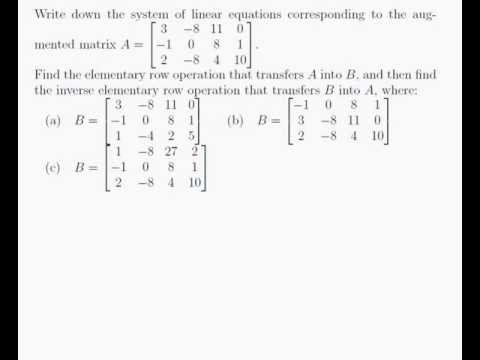
17 Elementary Row Operations with Example 1 - YouTube. In actuality, elementary row operations (or elementary column operations) have applicability to solving sets of simultaneous equations in more general settings where an inverse of the coefficients matrix may not exist. These matters are taken up in Appendix B., 29.05.2019 · Matrix inversion by elementary row operations Michael Friendly 2019-05-29. The following examples illustrate the steps in finding the inverse of a matrix using elementary row operations (EROs): Add a multiple of one row to another (rowadd()) Multiply one row by a constant (rowmult()) Interchange two rows (rowswap()).
The Gauss–Jordan and Simplex Algorithms
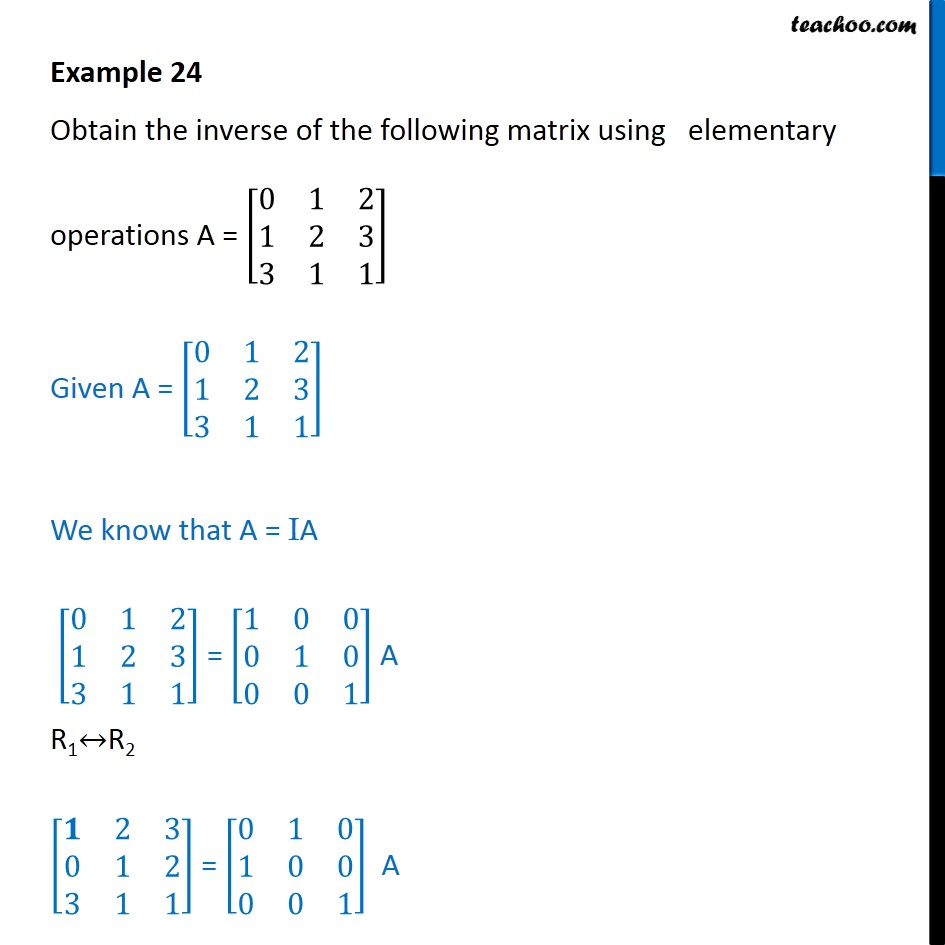
Mathematics IM Worked Examples ALGEBRA MATRICES AND. Elementary Row Operations Here are some examples of matrices. Matrix Dimension 2 3 [6 –5 0 1] 1 4 2 rows by 3 columns 1 row by 4 columns. 9 The Augmented Matrix of a Linear System. 10 The Augmented Matrix of a Linear System We can write a system of linear equations as a matrix, called the augmented matrix of the system, by writing only the coefficients and constants that appear in the https://ko.wikipedia.org/wiki/%EA%B8%B0%EB%B3%B8%ED%96%89%EB%A0%AC Elementary Row Operations Recall that an equation such as: 7(x-4)=14, may be solved for x by applying the following operations: dividing both sides of the equation by the same value, namely 7, to yield x-4=2, then adding the same quantity to both sides, namely 4, to yield x=6..

Elementary row operations and some applications 1. Elementary row operations Given an N × N matrix A, we can perform various operations that modify some of the rows of A. There are three classes of elementary row operations, which we shall denote using the following notation: 1. Rj ↔ Rk. This means that we interchange the jth row and kth row 1101 0011 0000 3. 1100 0110 0011 4. 1000 1100 0110 0011 5. 01111 00222 00003 00000 Given any matrix, we can always perform a sequence of elementary row operations to arrive at an equivalent matrix that has row echelon form.
(order may vary) of elementary row operations given below. • Interchanging two rows • Multiplying a row by a non zero constant • Adding a multiple of a row to another row Row-Echelon Form and Reduced Row-Echelon Form A matrix in row-echelon form has the following properties. of elementary operations. Since the elementary operations preserve the standard form of linear equations, we can trace the solution process by looking on the augmented matrix. In terms of the augmented matrix, the elementary operations are elementary row operations.
Problems of Elementary Row Operations. From introductory exercise problems to linear algebra exam problems from various universities. Basic to advanced level. Elementary row operations There are three elementary row operations that we can perform on an augmented matrix. The elementary row operations are: 1. interchanging two rows 2. multiplying a row by a non-zero constant 3. adding a multiple of one row to another The elementary row operations are reversible and so do not
You may notice that one of the three kinds of row operation is missing from this story. Row exchange my very well be necessary to obtain RREF. Indeed, so far in this chapter we have been working under the tacit assumption that \(M\) can be brought to the identity by just row multiplication and row addition. If row exchange is necessary, the Theorem 3 If B is obtained from A by an elementary row (or column)operation, then r(B)= r(A). Theorems 1 through 3 suggest a useful procedure for determining the rank of any matrix: Simply use elementary row operations to transform the given matrix to row-reduced form, and then count the number of …
Elementary row operations and some applications 1. Elementary row operations Given an N × N matrix A, we can perform various operations that modify some of the rows of A. There are three classes of elementary row operations, which we shall denote using the following notation: 1. Rj ↔ Rk. This means that we interchange the jth row and kth row Lecture 4e Elementary Row Operations and the Determinant (pages 264-8) We saw in the previous lecture that it is much easier to calculate the determinant of a triangular matrix, or better yet, a matrix with a row or column of all zeros. And we’ve already seen how to use elementary row operations to nd a row
You may notice that one of the three kinds of row operation is missing from this story. Row exchange my very well be necessary to obtain RREF. Indeed, so far in this chapter we have been working under the tacit assumption that \(M\) can be brought to the identity by just row multiplication and row addition. If row exchange is necessary, the Learn how to perform the matrix elementary row operations. These operations will allow us to solve complicated linear systems with (relatively) little hassle! If you're seeing this message, it means we're having trouble loading external resources on our website.
29.05.2019 · Matrix inversion by elementary row operations Michael Friendly 2019-05-29. The following examples illustrate the steps in finding the inverse of a matrix using elementary row operations (EROs): Add a multiple of one row to another (rowadd()) Multiply one row by a constant (rowmult()) Interchange two rows (rowswap()) Learn how to perform the matrix elementary row operations. These operations will allow us to solve complicated linear systems with (relatively) little hassle! If you're seeing this message, it means we're having trouble loading external resources on our website.
Learn how to perform the matrix elementary row operations. These operations will allow us to solve complicated linear systems with (relatively) little hassle! If you're seeing this message, it means we're having trouble loading external resources on our website. Elementary Row Operations Our goal is to begin with an arbitrary matrix and apply operations that respect row equivalence until we have a matrix in Reduced Row Echelon Form (RREF). The three elementary row operations are: (Row Swap) Exchange any two rows. (Scalar Multiplication) Multiply any row by a …
13.03.2014 · Tuesday, March 11 Intermediate Algebra Elementary Row Operations with first example. Lecture 4e Elementary Row Operations and the Determinant (pages 264-8) We saw in the previous lecture that it is much easier to calculate the determinant of a triangular matrix, or better yet, a matrix with a row or column of all zeros. And we’ve already seen how to use elementary row operations to nd a row
elementary row operations: (1) row swapping, (2) row multiplication, and (3) row addition. Row multiplication and row addition can be combined together. (1) In row swapping, the rows exchange positions within the matrix. The matrix resulting from a row operation or sequence of row operations is called row equivalent to the original matrix. Matrix Row Operations: Examples (page 2 of 2) In practice, the most common procedure is a combination of row multiplication and row addition. Thinking back to solving two-equation linear systems by addition, you most often had to multiply one row by some number before you added it to the other row.
Matrix Row Operations: Examples (page 2 of 2) In practice, the most common procedure is a combination of row multiplication and row addition. Thinking back to solving two-equation linear systems by addition, you most often had to multiply one row by some number before you added it to the other row. Elementary row operations There are three elementary row operations that we can perform on an augmented matrix. The elementary row operations are: 1. interchanging two rows 2. multiplying a row by a non-zero constant 3. adding a multiple of one row to another The elementary row operations are reversible and so do not
Elementary Row Operations web.math.ucsb.edu
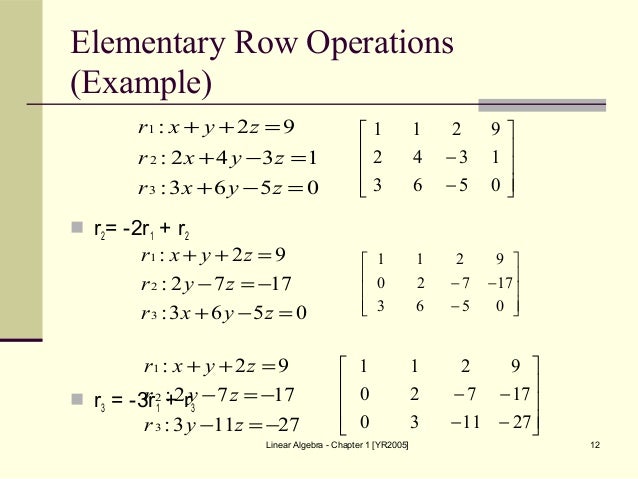
14 Row reduction and subspaces. Elementary row operations. by Marco Taboga, PhD. Elementary row operations are simple operations that allow to transform a system of linear equations into an equivalent system, that is, into a new system of equations having the same solutions as the original system., 1101 0011 0000 3. 1100 0110 0011 4. 1000 1100 0110 0011 5. 01111 00222 00003 00000 Given any matrix, we can always perform a sequence of elementary row operations to arrive at an equivalent matrix that has row echelon form..
Elementary Row Operations Problems in Mathematics
Gaussian elimination Wikipedia. In actuality, elementary row operations (or elementary column operations) have applicability to solving sets of simultaneous equations in more general settings where an inverse of the coefficients matrix may not exist. These matters are taken up in Appendix B., 13.03.2014 · Tuesday, March 11 Intermediate Algebra Elementary Row Operations with first example..
Rank, Row-Reduced Form, and Solutions to Example 1. Consider the matrix A given by. Using the three elementary row operations we may rewrite A in an echelon form as or, continuing with additional row operations, in the reduced row-echelon form. From the above, the homogeneous system has a solution that can be read as or in vector form as. four operations, and that none of these operations changes the set of solutions. The first step in using elementary row operations to solve a system of equations is to write down the so-called augmented coefficient matrix of the system, which is the2 3 matrix of just the numbers above: 2 4 3 2 8 2 3 7 3 5: (1′) We apply elementary row
elementary row operations: (1) row swapping, (2) row multiplication, and (3) row addition. Row multiplication and row addition can be combined together. (1) In row swapping, the rows exchange positions within the matrix. The matrix resulting from a row operation or sequence of row operations is called row equivalent to the original matrix. four operations, and that none of these operations changes the set of solutions. The first step in using elementary row operations to solve a system of equations is to write down the so-called augmented coefficient matrix of the system, which is the2 3 matrix of just the numbers above: 2 4 3 2 8 2 3 7 3 5: (1′) We apply elementary row
Elementary Row Operations (EROs) represent the legal moves that allow us to write a sequence of row-equivalent matrices (corresponding to equivalent systems) until we obtain one whose corresponding solution set is easy to find. There are three types of EROs: are not in row echelon form (also not in reduced row echelon form) since the leading 1 in the second row is not in the left of the leading 1 in the third row and all the other entries above the leading 1 in the third column are not 0. Definition of elementary row operation: There are 3 elementary row operations: 1. Interchange two rows 2.
1101 0011 0000 3. 1100 0110 0011 4. 1000 1100 0110 0011 5. 01111 00222 00003 00000 Given any matrix, we can always perform a sequence of elementary row operations to arrive at an equivalent matrix that has row echelon form. 1101 0011 0000 3. 1100 0110 0011 4. 1000 1100 0110 0011 5. 01111 00222 00003 00000 Given any matrix, we can always perform a sequence of elementary row operations to arrive at an equivalent matrix that has row echelon form.
Write down the corresponding augmented matrix, use elementary row operations to put this matrix in reduced row echelon form. Hence nd all solutions of this system and give a geometric interpration of your answer. 3. See Page 5 for worked solutions. Suppose an augmented matrix associated with a system of linear equations has the Learn how to perform the matrix elementary row operations. These operations will allow us to solve complicated linear systems with (relatively) little hassle! If you're seeing this message, it means we're having trouble loading external resources on our website.
Adding −2 times the first row to the second row yields . If this same elementary row operation is applied to I, then the result above guarantees that EA should equal A′. You may verify that . is indeed true. If A is an invertible matrix, then some sequence of elementary row operations will transform A … Elementary row operations. by Marco Taboga, PhD. Elementary row operations are simple operations that allow to transform a system of linear equations into an equivalent system, that is, into a new system of equations having the same solutions as the original system.
Adding −2 times the first row to the second row yields . If this same elementary row operation is applied to I, then the result above guarantees that EA should equal A′. You may verify that . is indeed true. If A is an invertible matrix, then some sequence of elementary row operations will transform A … Elementary row operations There are three elementary row operations that we can perform on an augmented matrix. The elementary row operations are: 1. interchanging two rows 2. multiplying a row by a non-zero constant 3. adding a multiple of one row to another The elementary row operations are reversible and so do not
Matrix Row Operations: Examples (page 2 of 2) In practice, the most common procedure is a combination of row multiplication and row addition. Thinking back to solving two-equation linear systems by addition, you most often had to multiply one row by some number before you added it to the other row. ES.1803 Topic 14 Notes Jeremy Orlo 14 Row reduction and subspaces 14.1 Goals 1.Be able to put a matrix into row reduced echelon form (RREF) using elementary row operations. 2.Know the de nitions of null and column space of a matrix. 3.Be able to use RREF to nd bases and describe the null and column spaces of a matrix.
are not in row echelon form (also not in reduced row echelon form) since the leading 1 in the second row is not in the left of the leading 1 in the third row and all the other entries above the leading 1 in the third column are not 0. Definition of elementary row operation: There are 3 elementary row operations: 1. Interchange two rows 2. Elementary operations for matrices play a crucial role in finding the inverse or solving linear systems. They may also be used for other calculations. On this page, we will discuss these type of operations. Before we define an elementary operation, recall that to an nxm matrix A, we can associate n rows and m columns. For example, consider the
1.2 Elementary Row Operations Example 1.2.1 Find all solutions of the following system : x + 2y z = 5 3x + y 2z = 9 x + 4y + 2z = 0 In other (perhaps simpler) examples we … Gaussian elimination, also known as row reduction, is an algorithm in linear algebra for solving a system of linear equations. It is usually understood as a sequence of operations performed on the corresponding matrix of coefficients.
Math 211 Linear Algebra. Elementary Row Operations Our goal is to begin with an arbitrary matrix and apply operations that respect row equivalence until we have a matrix in Reduced Row Echelon Form (RREF). The three elementary row operations are: (Row Swap) Exchange any two rows. (Scalar Multiplication) Multiply any row by a …, abelian group augmented matrix basis basis for a vector space characteristic polynomial commutative ring determinant determinant of a matrix diagonalization diagonal matrix eigenvalue eigenvector elementary row operations exam field theory finite group group group homomorphism group theory homomorphism ideal inverse matrix invertible matrix kernel linear algebra linear combination linearly.
Lecture 4f Calculating the Determinant Using Row
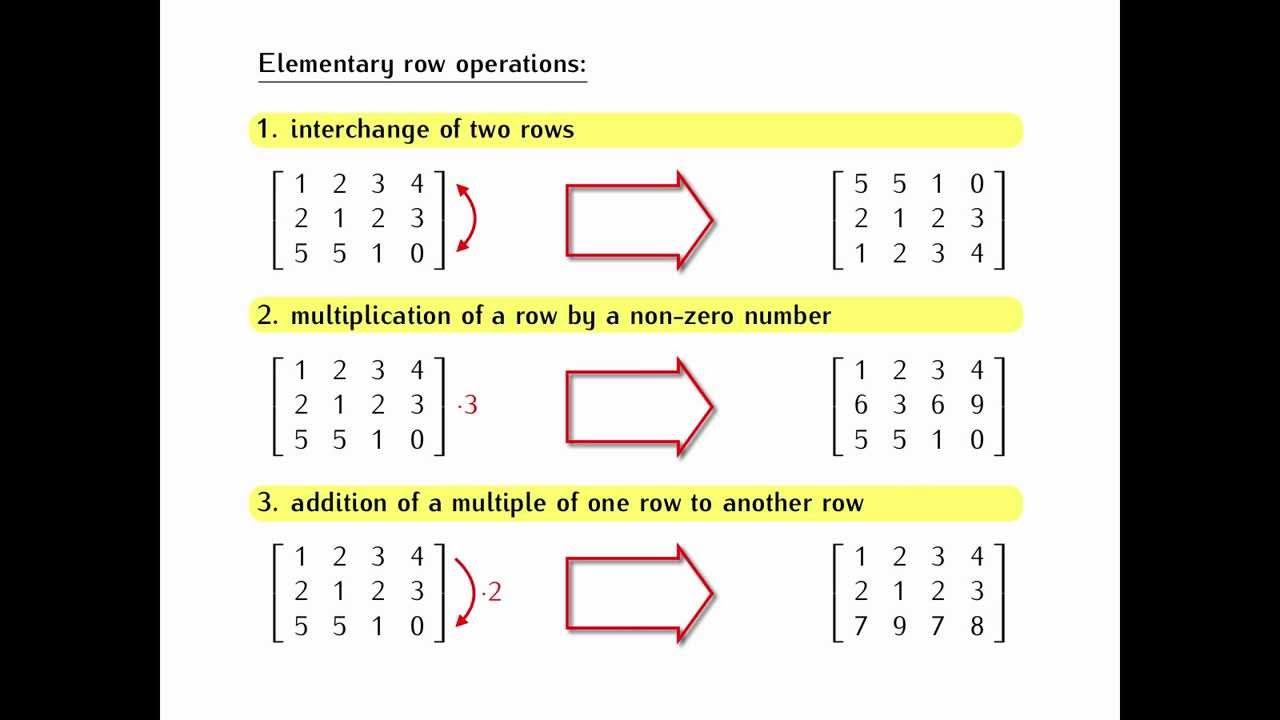
Elementary row operations statlect.com. are not in row echelon form (also not in reduced row echelon form) since the leading 1 in the second row is not in the left of the leading 1 in the third row and all the other entries above the leading 1 in the third column are not 0. Definition of elementary row operation: There are 3 elementary row operations: 1. Interchange two rows 2., Lecture 4e Elementary Row Operations and the Determinant (pages 264-8) We saw in the previous lecture that it is much easier to calculate the determinant of a triangular matrix, or better yet, a matrix with a row or column of all zeros. And we’ve already seen how to use elementary row operations to nd a row.
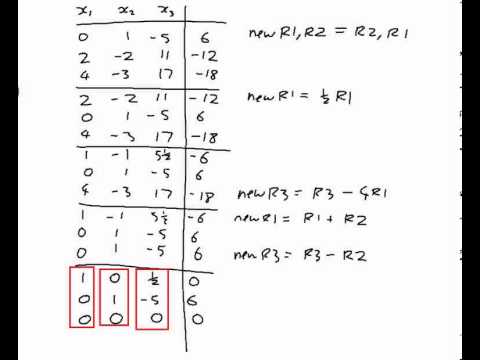
Center for Academic Support – MWSU Missouri Western. Math 211 - Linear Algebra True/False Solution Examples In the True/False problems in the textbook, you need to give complete explanations, and not just the word \True" or \False". The following are examples of complete, correct solutions to a few of these problems. Section 1.1, page 12, Problem 24. a. Elementary row operations on an augmented, Row (and column) operations can make a matrix ‘nice’ A matrix has a row-reduced form (and a column-reduced form, but let’s study rows), which we obtain by row operations to make it as simple as possible. This form is such that: each non-zero row starts with some number of 0s, then an initial 1, ….
10.3 Matrices and Systems Of Linear Equations
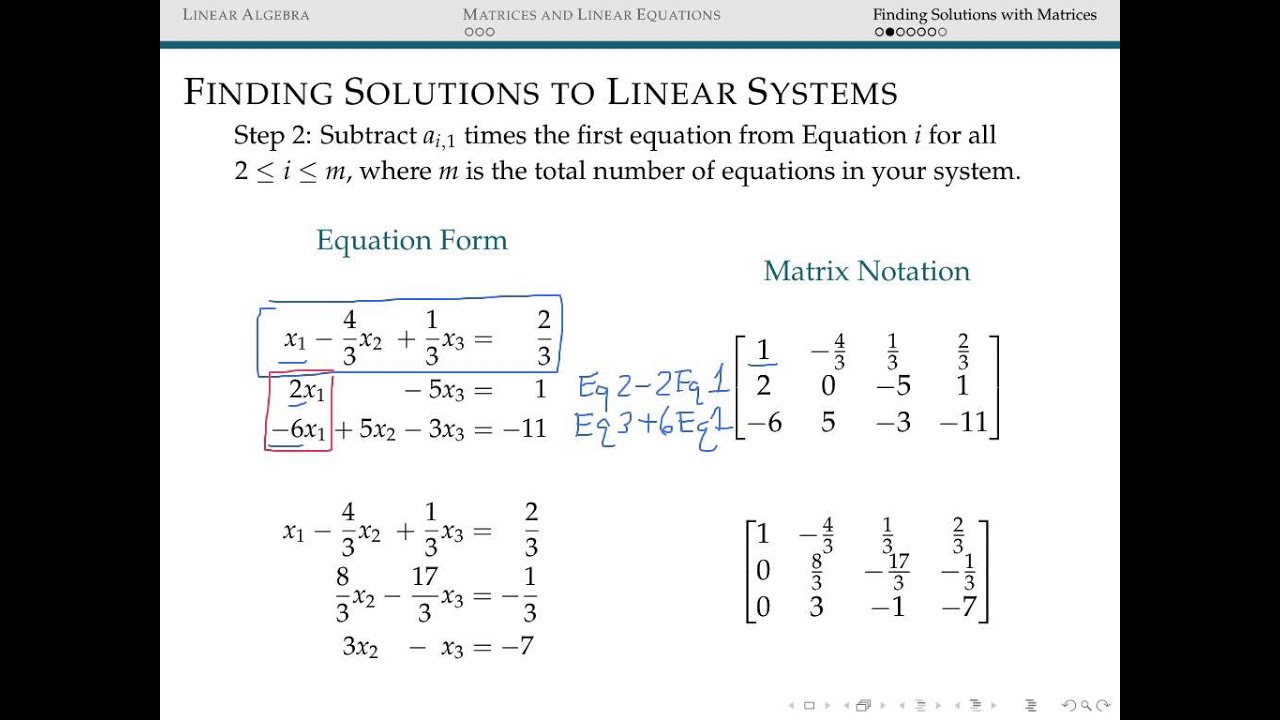
2.4 Elementary Row Operations and Row-Echelon Matrices. Chapter 1 Matrices 1.1 Definition of a Matrix Definition 1.1.1 (Matrix) A rectangular array of numbers is called a matrix. We shall mostly be concerned with matrices having real numbers as entries. https://ko.wikipedia.org/wiki/%EA%B8%B0%EB%B3%B8%ED%96%89%EB%A0%AC 25.10.2013 · This is the fourth video of a series from the Worldwide Center of Mathematics explaining the basics of matrices. This video deals with elementary row operations on matrices (EROs). For more math.

Write down the corresponding augmented matrix, use elementary row operations to put this matrix in reduced row echelon form. Hence nd all solutions of this system and give a geometric interpration of your answer. 3. See Page 5 for worked solutions. Suppose an augmented matrix associated with a system of linear equations has the Elementary row operations There are three elementary row operations that we can perform on an augmented matrix. The elementary row operations are: 1. interchanging two rows 2. multiplying a row by a non-zero constant 3. adding a multiple of one row to another The elementary row operations are reversible and so do not
ES.1803 Topic 14 Notes Jeremy Orlo 14 Row reduction and subspaces 14.1 Goals 1.Be able to put a matrix into row reduced echelon form (RREF) using elementary row operations. 2.Know the de nitions of null and column space of a matrix. 3.Be able to use RREF to nd bases and describe the null and column spaces of a matrix. 29.05.2019 · Matrix inversion by elementary row operations Michael Friendly 2019-05-29. The following examples illustrate the steps in finding the inverse of a matrix using elementary row operations (EROs): Add a multiple of one row to another (rowadd()) Multiply one row by a constant (rowmult()) Interchange two rows (rowswap())
This is an introduction to linear algebra. The main part of the book features row operations and everything is done in terms of the row reduced echelon form and specific algorithms. At the end, the more abstract notions of vector spaces and linear transformations on vector spaces are presented. Elementary Row Operations Here are some examples of matrices. Matrix Dimension 2 3 [6 –5 0 1] 1 4 2 rows by 3 columns 1 row by 4 columns. 9 The Augmented Matrix of a Linear System. 10 The Augmented Matrix of a Linear System We can write a system of linear equations as a matrix, called the augmented matrix of the system, by writing only the coefficients and constants that appear in the
Elementary matrix row operations. Matrix row operations. Practice: Matrix row operations. This is the currently selected item. Next lesson. Row-echelon form and Gaussian elimination. Matrix row operations. Determine the matrix that is the result of performing a specific row operation on a given matrix. If you're seeing this message, it means we're having trouble loading external resources on It is a special type of matrix that can be illustrate 2d and 3d transformations. Let’s have a look on different types of elementary operations. Types of Elementary Operations. There are two types of elementary operations of a matrix: Elementary row operations: when they …
elementary row transformations. If we want to perform an elementary row transformation on a matrix A, it is enough to pre-multiply A by the elemen-tary matrix obtained from the identity by the same transformation. This is illustrated below for each of the three elementary row transformations. 1.5.2 Elementary Matrices and Elementary Row Opera-tions are not in row echelon form (also not in reduced row echelon form) since the leading 1 in the second row is not in the left of the leading 1 in the third row and all the other entries above the leading 1 in the third column are not 0. Definition of elementary row operation: There are 3 elementary row operations: 1. Interchange two rows 2.
Elementary Row Operations Here are some examples of matrices. Matrix Dimension 2 3 [6 –5 0 1] 1 4 2 rows by 3 columns 1 row by 4 columns. 9 The Augmented Matrix of a Linear System. 10 The Augmented Matrix of a Linear System We can write a system of linear equations as a matrix, called the augmented matrix of the system, by writing only the coefficients and constants that appear in the 21.12.2015 · The elementary column operations are exactly the same operations done on the columns. Elementary Column Operation: Those three operations for rows, if applied to columns in the same way, we get elementary column operation. As we have already discussed row transformation in detail, we will briefly discuss column transformation. The rules for
Elementary Row Operations (EROs) represent the legal moves that allow us to write a sequence of row-equivalent matrices (corresponding to equivalent systems) until we obtain one whose corresponding solution set is easy to find. There are three types of EROs: ES.1803 Topic 14 Notes Jeremy Orlo 14 Row reduction and subspaces 14.1 Goals 1.Be able to put a matrix into row reduced echelon form (RREF) using elementary row operations. 2.Know the de nitions of null and column space of a matrix. 3.Be able to use RREF to nd bases and describe the null and column spaces of a matrix.
elementary row transformations. If we want to perform an elementary row transformation on a matrix A, it is enough to pre-multiply A by the elemen-tary matrix obtained from the identity by the same transformation. This is illustrated below for each of the three elementary row transformations. 1.5.2 Elementary Matrices and Elementary Row Opera-tions It is a special type of matrix that can be illustrate 2d and 3d transformations. Let’s have a look on different types of elementary operations. Types of Elementary Operations. There are two types of elementary operations of a matrix: Elementary row operations: when they …
(order may vary) of elementary row operations given below. • Interchanging two rows • Multiplying a row by a non zero constant • Adding a multiple of a row to another row Row-Echelon Form and Reduced Row-Echelon Form A matrix in row-echelon form has the following properties. Write down the corresponding augmented matrix, use elementary row operations to put this matrix in reduced row echelon form. Hence nd all solutions of this system and give a geometric interpration of your answer. 3. See Page 5 for worked solutions. Suppose an augmented matrix associated with a system of linear equations has the
elementary row transformations. If we want to perform an elementary row transformation on a matrix A, it is enough to pre-multiply A by the elemen-tary matrix obtained from the identity by the same transformation. This is illustrated below for each of the three elementary row transformations. 1.5.2 Elementary Matrices and Elementary Row Opera-tions 21.12.2015 · The elementary column operations are exactly the same operations done on the columns. Elementary Column Operation: Those three operations for rows, if applied to columns in the same way, we get elementary column operation. As we have already discussed row transformation in detail, we will briefly discuss column transformation. The rules for
(order may vary) of elementary row operations given below. • Interchanging two rows • Multiplying a row by a non zero constant • Adding a multiple of a row to another row Row-Echelon Form and Reduced Row-Echelon Form A matrix in row-echelon form has the following properties. abelian group augmented matrix basis basis for a vector space characteristic polynomial commutative ring determinant determinant of a matrix diagonalization diagonal matrix eigenvalue eigenvector elementary row operations exam field theory finite group group group homomorphism group theory homomorphism ideal inverse matrix invertible matrix kernel linear algebra linear combination linearly

